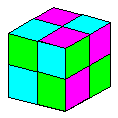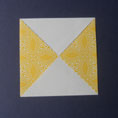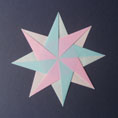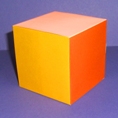| Origami Heaven A paperfolding paradise The website of writer and paperfolding designer David Mitchell x |
|||||||||||||
|
|||||||||||||
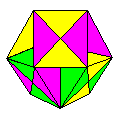 |
|||||||||||||
| Introduction | |||||||||||||
| Minimalist abstract origami is a form of
either geometric sculpture, abstract representational
origami or paperfolding puzzles in which the designer
aims to create an abstract form or pattern in the
smallest possible number of folds ... or, at least, a
very small number. Such designs may be made using either
single sheets, multiple sheets or using modules. Paperfolding puzzles may require that a particular motif, shape or pattern be arrived at in the minimum number of active folds, and on this basis should be considered a form of minimalist abstract origami. In thinking about minimalist origami of all kinds it is useful to distinguish between active and passive folds, active folds being those which are used in the final design and passive folds (location folds) being those which are not. I only count the active folds when considering the number of folds that a design requires. Minimalist Abstract Single Sheet Origami Although there is no hard and fast rule it seems reasonable to apply the same criteria to an abstract design as would apply to a representational design and to consider it minimalist if the final design is made by using five active folds or fewer. Paul Jackson is famous for, among other things, inventing a form of minimalist abstract origami which he calls One Crease Origami. Minimalist Abstract Multiple Sheet Origami In the case of multiple sheet designs it seems sensible to think of each part of the overall design as a separate minimalist element. I would regard a multiple sheet design as minimalist if each of the elements was made using the smallest possible number of active folds ... or, at least, a very small number ... irrespective of the total number of folds in the design as a whole. Minimalist Abstract Modular Origami In the case of modular designs, since the modules for many classic designs, such as Paul Jackson's Cube and Robert Neale's Octahedron, which are not considered minimalist, are created using just four active folds, the maximum number of active folds available to create a module for a minimalist design is just three. A minimalist modular design is, of course, still modular and therefore, by definition, required to be self-integrating (see the Definitions and Notes page) and reasonably stable in its assembled form. Meeting such tight criteria means that it is likely compromises will have to be made elsewhere in the design. This may mean, for instance, that the design may be best made from card, rather than paper, as, for instance, in the case of the traditional 6-Card Cube, or that the number of modules a design requires might need to be to be increased beyond what might otherwise be acceptable, as in the case of my own 2-Fold Cube, or that the paper shape might need to be, for instance, triangular, as in the case of my 2-Fold Star. To some extent stability may also need to be sacrificed. The classic example of this is Kenneth Kawamura's Butterfly Ball, the module for which is made with just three structural folds, although in this case the instability of the design is cleverly exploited as a feature. |
|||||||||||||
| Specimen Designs | |||||||||||||
| A few specimen designs are shown below. A page giving details of my own contributions to the minimalist representational genre can be found here. | |||||||||||||
| Minimalist Abstract Single Sheet Designs | |||||||||||||
| To be added later. | |||||||||||||
| Minimalist Abstract Multiple Sheet Designs | |||||||||||||
|
|||||||||||||
| Minimalist Abstract Modular Designs | |||||||||||||
| 1- Fold Designs | |||||||||||||
|
|||||||||||||
| 2- Fold Designs | |||||||||||||
|
|||||||||||||
| 3- Fold Designs | |||||||||||||
|
|||||||||||||
|
|||||||||||||
